John Prior's Ancestors |
Click on a name for info, click on the back arrow to go back, click Home to go to the main page, or click for an Alphabetic List of all Names. |
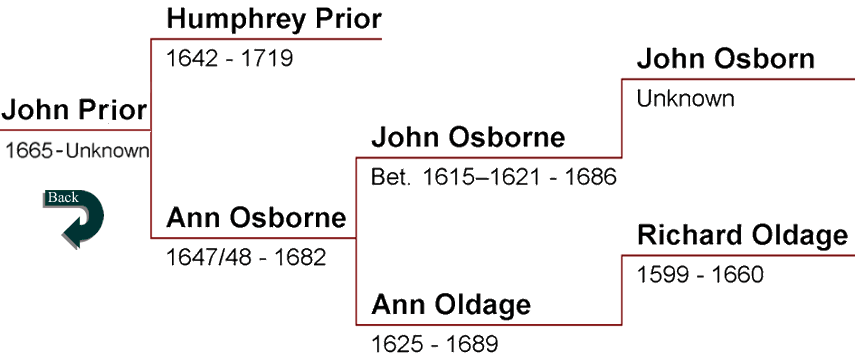 |
| Note: Before 1752 the year began on March 25th. Dates between January 1st and March 24th were at the end of the year, not the beginning. |
Humphrey Prior could have been born about 1642/3 in Windsor, Hartford, Connecticut, to one of the sons of Thomas Prior and Sarah Prime. Some researchers believe it was Daniel Prior and Mary Hatch, but without documentation there is no certainty. There is also a possibility he was born in England to Thomas’ son Thomas and came over as a young adult. To confuse matters more, there is a record in the England Births and Christenings, 1538-1975 collection for a Humphery Pryor baptized on June 6, 1641 in St Andrew, Holborn, London, England to Edward and Ellen Pryor. Being that Humphrey is not a common name, this could be our Humphrey. So his ancestry is truly uncertain.
Ann died in 1682 and Humphrey married Mary Whitcomb sometime after. The marriage date has been estimated at between 1683 and 1686. Stiles states in volume 2 of his book “he prob.[ably] m.[arried] again, as Col. Bee, 4, gives record of m.[arriage] of Humphrey and Mary Whitcomb, no date, but from context, probably 1686; The Widow Mary P.[robate] d.[ied] 10 July, 1723.” It is believed that no children were born of this marriage. Humphrey Prior died in Windsor before April 9, 1719, the earliest date of his probate papers, which consisted of a bond that calls him deceased dated April 9th, an inventory dated July 6th, an Account of Administration Petition, dated August 4th, but no will. The petition paper seems to have the date of eighth April, 1719, on the top following Humphrey’s name, so he may have died on the 8th. (Mouse over and click on the petition paper image left to enlarge in a new window/tab.) The bond tells us that Humphrey owed most of his estate to a creditor named John Flyer. Humphrey’s estate was worth £03-05-06, but after the bond was paid, his widow only received £0-02-01. It is believed he was buried in the Palisado Cemetery in Windsor. |
| ~< Back to Chart >~ |
Ann Osborne was born on January 18, 1647/48 in Windsor, Hartford County, Connecticut, the eldest daughter and second child of ten born to John Osborne and Ann Oldage. (See her birth record image in her mother's bio.) She married Humphrey Prior there on November 12, 1663, and had at least two children there – ancestor John; and Daniel on December 19, 1667.Some researchers believe that John may have had a twin brother who died at birth; and that there was another unnamed son in 1670, who died as an infant.Documentation exists only for John and Daniel. Ann spent her entire life in Windsor and died there on September 29, 1682, before the death of both of her parents. |
| ~< Back to Chart >~ |
In volume 1 of The History and Genealogies of Ancient Windsor, Connecticut, Henry Reed Stiles states that on his wedding day, John purchased the home and lot next to his father-in-law’s home, which was located near an old “Indian burying place,” that was discovered in about 1873 during river bank maintenance. (Mouse over image right.) It seems John was a large landowner and after his father-in-law's death in 1660, John owned that land also. Stiles says “he is said to have owned nearly 1,000 acres.” Stiles also states that in 1663 John signed “petitions relative to the farms at Hammonoscett, are sufficiently indicative of Windsor’s interest in that enterprise, viz:” Hinman states “The very few dates to be found for several years in the first records of Windsor, renders it difficult to designate time in all cases, and for three or four of the first years of the settlement there was little or no record. The following list of names are found in the land record of Windsor, in the hand writing of Bray Rosseter, Town Clerk of Windsor until 1652. Those names which have no date annexed, are entered 1652, though many of them were probably much earlier. Thomas Marshfield, 1642, . . . John Osborn, '52, . . . The foregoing persons appear at the dates given as land holders in Windsor-Hayden. Many of these persons are knoyn to have been in the colony several years before the above dates.” Stiles reports that in 1659-60, John paid 7s for short seats in the Meeting House for his wife and himself. Stiles quotes John Alden Stoughton from the
“I John Osborn sen. of Windsor do make this my last Will & Testament: I give to my wife Ann Osborn my personal and real Estate during her natural life, except that parcell of Land only that I now improve at Namerick which I give to my son John, Within a year and a day after my decease. I give to my son Samuel my now dwelling house and Lands adjoyning, after mine and my wive's decease, he paying to his brothers and sisters such legacies as hereinafter shall be expressed. I give to my son Nathaniel that part of my house lott west side of Connecticut River, east of the Town Street, bounded North by John Gaylord Jr., south by Robert Watson, East by Isaac Pinney's Meadow, after the decease of my wife and myself. I give to my gr. son Daniel Prior my Wood lott above Namerick, bounded south by Jacob Drake, and £ 10. My son Samuel to pay his four sisters, Mary, Hanna, Ester & Sarah, £10 to Each. Samuel to pay my gr. child Hana Shadduck £5 in case she abide with my wife until 18 years of age or till my wives decease. I constitute my wife Ann sole Executrix, and desire Jacob Drake, Daniel Hayden & Nathaniel Gaylord to be Overseers. John X Osborn Sen. Witness: Jacob Drake, Mary Drake.”
|
| ~< Back to Chart >~ |
Ann Oldage was born on January 15, 1626/7 in either Windsor, Hartford County, Connecticut, or about 1625 in Dorchester, England, the only child of Richard Oldage and his wife. Researchers disagree on her birth because documents can’t be found in either country. Ann and John had ten children together all born in Windsor – J
|
| ~< Back to Chart >~ |
John Osborn is said to be the father of John Jr. because R.R. Hinman in his book, A Catalogue of the Names of the First Puritan Settlers of the Colony of Connecticut stated about John Jr: “He probably was the son of John of Weymouth.” Hinman probably was referring to Weymouth, Massachusetts not England because his book is based on information taken from records, etc., collected from the state and town records of Hartford. Savage in volume three of A Genealogical Dictionary of the First Settlers of New England says there was a John Osborne married to Mary living in Weymouth, Massachusetts, at the time, who had a son named John born in 1640, so this could not be our John’s father. No other John Osborne’s can be found in Weymouth, but there were many other males with the surname of Osborn/Osborne in Weymouth, and many other Osborn's living in other areas of New England, so this ancestry is very uncertain. |
| ~< Back to Chart >~ |
Richard Oldage is said to have been of Welsh origin, probably born about 1599 in Dorchester, England. The name is variously spelled Oldage, Oldige, Oldridge, or Olderige on different records. Many researchers including R.R. Hinman, James Savage, John Farmer, Orrando Perry Dexter, and the NE Historic and Genealogical Society say he came to Windsor, Connecticut, from Dorchester with Mr. Huet in 1639. Windsor Records state “Ephraim Hewet and others came up from Massachusetts Bay to Windsor to settle here August 17, 1639.” In 1638, in England, Huet had been prosecuted for “neglect of Ceremonies and then emigrated to America in 1639, and landed at Boston, Massachusetts.” He changed his name from Hewet to Huet, and came to Windsor where he had a relative, William Buell (or Beville) living. But it is not known exactly when Richard came to the New World. Click for more history. Richard is listed as a founder of Windsor in many books and organizations including First Settlers of Windsor, Connecticut, Recorded in the Town Records of 1640; volume 5 of The New England Historical and Genealogical Register; and The Society Of Colonial Wars In The State Of Connecticut. Henry Reed Stiles in volume two of his book The History and Genealogies of Ancient Windsor, Connecticut says “OLDAGE, Richard, land gr. W.[indsor]” In volume one Stiles describes the land grant as “1640, 30 Aug.; lot gr[anted] 12 r.[ods] wide next S.[outh] John Stiles (betw.[een] the Colonel Ellsworth ho.[use] and about 40 r.[ods] N[orth] of the Major Ellsworth tenant ho.[use]), and ext.[ended] from meadow on E.[ast] to Rocky Hill on W[est].” In volume 1 of The Public Records of the Colony of Connecticut, on June 5, 1645, Richard was one of two defendants “in an action of the case to the damage of £30.” On May 21, 1647, the jury found for the defendants and awarded them the “costs of court.” Stiles says that extracts from town acts state that “at a meeting of the townsmen” held on February 4, 1655/6, “Richard Oldage and Samuel Marshall shall be propounded to the General court to be appointed sealers of leather.” Richard had a wife born probably about 1602 in England, but her name is unknown. There are no birth, marriage, passenger ship, or death records to give us a clue as to where and when she died. She may have died in England, come to America with her husband and child, or had her child here and died. They only had one child, ancestor Ann. Richard never married again, so the Oldage name became extinct with his death. Richard Oldage died on January 27, 1660, in Windsor, Connecticut. (View his death record image above in John Osborne's bio. Mouse over and click on his probate record image on right below, to enlarge it in a new window/tab.) His probate record, as printed in A Digest of the Early Connecticut Probate Records, reads as follows: “Oldage, Richard, Windsor. Died 27 January, 1660. Invt. taken by Deacon Gaylord and Humphrey Pinney. And shortly after an Inventori was taken of the estat that he left conserning which before his death he had before witnes said that his will was that his sonn in law John Osbon should have all that he had and he was to alow him maintenanc whilst he lived and so was to take all and paye all. Witnes: Mat:Grant, Tho:Dibble.”
“Imprimis his howse and home lott 8 ac 3 quartus valued at 40-0-0 |
| ~< Back to Chart >~ |
Windsor's History
The coastal areas and riverways were traditional areas of settlement by various cultures of indigenous peoples, who had been in the region for thousands of years. They relied on the rivers for fishing, water and transportation. Before European contact, the historic Pequot and Mohegan tribes had been one Algonquian-speaking people. After they separated, they became competitors and traditional enemies in the Connecticut region. During the first part of the 17th century, the Pequot and Mohegan Nations had been at war. The Podunk were forced to pay tribute to the more powerful Pequot, who claimed their land. Eventually, the Podunk invited a small party of settlers from Plymouth, Massachusetts to settle as a mediating force between the other tribes. In exchange they granted them a plot of land at the confluence of the Farmington River and the west side of the Connecticut River. After Edward Winslow came from Plymouth to inspect the land, William Holmes led a small party, arriving at the site on September 26, 1633 where they founded a trading post. Native Americans referred to the area as Matianuck. It was about 50 miles up river, at the end of waters navigable by ship and above the Dutch fort at Hartford, offering an advantageous location for the English to trade with the Indians before they reached the Dutch. In 1634, a party of around 30 people, sponsored by Sir Richard Saltonstall, and led by the Stiles brothers, Francis, John and Henry settled in the Windsor area. Governor John Winthrop of the Massachusetts Bay Company acknowledged in a letter to Sir Richard Saltonstall that the Stiles party was, in fact, the first group to settle Connecticut.
In 1637, the colony's General Court changed the name of the settlement from Dorchester to Windsor, named after the town of Windsor England on the River Thames. The first highway in the Connecticut Colony opened in 1638 between Windsor and Hartford. Two years later, the highway was extended north to the 1636 settlement at Springfield, and thus the three settlements that came to dominate the region for much of colonial history were connected. In 1648, an event took place that would forever change the boundaries of the Connecticut River Valley. During a grain famine, the founder of Springfield, William Pynchon, was given consent by Windsor and Hartford to negotiate a price for grain for the three settlements with the Natives. First, the Natives refused to sell grain at the usual market price, and then refused to sell it at "a reasonable price." Pynchon refused to buy it, attempting to teach the Natives a peaceful lesson about integrity and reliability. Windsor's cattle were starving, however, and the citizens of Hartford were furious. With Windsor's consent, Hartford commissioned the famous Indian-fighter John Mason to travel to Springfield with "money in one hand and a sword in the other" to threaten the Natives, and thereby force the grain trade. The Natives capitulated and ultimately sold their grain. After "negotiating the trade," Mason refused to share the grain with Springfield, and to add further insult, insisted that Springfield pay a tax when sailing ships past Windsor. Outraged, Springfield forever sided with the Massachusetts Bay Colony, a faraway, theocracy based in Boston, rather than with the Connecticut Colony, which was much closer geographically and far more compatible ideologically. Windsor played a neutral role in the colonial rivalry between Hartford and Springfield; however, Windsor's direct border with both settlements caused many discussions about whether to align with Massachusetts or Connecticut. Ultimately, Windsor sided with Connecticut. |
| ~< Back to Chart >~ |
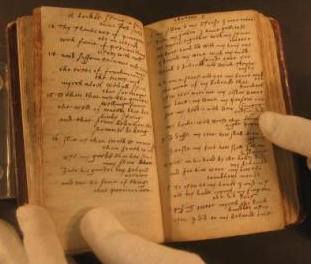 He married Ann Osborne in Windsor, Connecticut, on November 12, 1663. They had at least four children and it is believed they lived all their lives in Windsor. There is an early Connecticut Census record for Humfrey Prior living in Windsor in 1669. In Volume 1 of The History and Genealogies of Ancient Windsor, Connecticut, Henry Reed Stiles reports that in Matthew Grant's Diary (mouse over photo right) under the year 1675, Humphrey Prior was one of the 37 men who were in the taxpayer class of “Family and horse”; on June 11, 1676 “Humphrey Prior . . . gave to the voluntary contribution made for the poor . . 2s. 6d.” (the Connecticut Relief Fund); on August 17, 1677, Humphrey Prior had 2 children; and on May 13, 1680 Humphrey was one of the signers of The Petition of Inhabitants on the East Side of the Great River, to the General Assembly of the Colony of Connecticut to ask that the area be made a township, so they could build a church. In volume 2 of the same book, Stiles states “In 1696/7, he was app.[ointed] fence warden east side Great River, below Scantic; in 1696 he was collector. It seems prob.[ably] that he either ret.[turned] to west side of Conn. River, or re.[moved] to Enfield. He lived for a time in Simsbury. It seems prob.[ably], also, that the greater part of his est.[ate] was in Enf.[ield] When an administrator was appointed to his estate, 9 Apl., 1719, the estate was spoken of as ‘of H. P., late of Windsor.’”
He married Ann Osborne in Windsor, Connecticut, on November 12, 1663. They had at least four children and it is believed they lived all their lives in Windsor. There is an early Connecticut Census record for Humfrey Prior living in Windsor in 1669. In Volume 1 of The History and Genealogies of Ancient Windsor, Connecticut, Henry Reed Stiles reports that in Matthew Grant's Diary (mouse over photo right) under the year 1675, Humphrey Prior was one of the 37 men who were in the taxpayer class of “Family and horse”; on June 11, 1676 “Humphrey Prior . . . gave to the voluntary contribution made for the poor . . 2s. 6d.” (the Connecticut Relief Fund); on August 17, 1677, Humphrey Prior had 2 children; and on May 13, 1680 Humphrey was one of the signers of The Petition of Inhabitants on the East Side of the Great River, to the General Assembly of the Colony of Connecticut to ask that the area be made a township, so they could build a church. In volume 2 of the same book, Stiles states “In 1696/7, he was app.[ointed] fence warden east side Great River, below Scantic; in 1696 he was collector. It seems prob.[ably] that he either ret.[turned] to west side of Conn. River, or re.[moved] to Enfield. He lived for a time in Simsbury. It seems prob.[ably], also, that the greater part of his est.[ate] was in Enf.[ield] When an administrator was appointed to his estate, 9 Apl., 1719, the estate was spoken of as ‘of H. P., late of Windsor.’”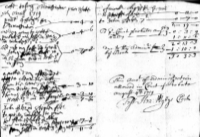
 (Mouse over her death record image on right.) Savage in volume 3 of his book A Genealogical Dictionary of the First Settlers of New England says about Humphrey’s wife Ann: “His w.[ife] d.[ied] before her f.[ather.]” It is believed she was buried in the Palisado Cemetery in Windsor.
(Mouse over her death record image on right.) Savage in volume 3 of his book A Genealogical Dictionary of the First Settlers of New England says about Humphrey’s wife Ann: “His w.[ife] d.[ied] before her f.[ather.]” It is believed she was buried in the Palisado Cemetery in Windsor.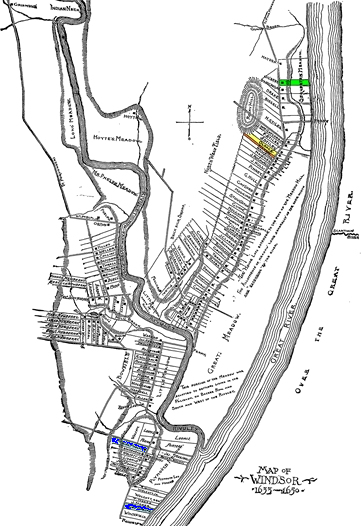 John Osborne was born in the United Kingdom, probably England between 1615 and 1621 and is said to be of Welsh origin by tradition. R.R. Hinman in his book A Catalogue of the Names of the First Puritan Settlers of the Colony of Connecticut says “He probably was the son of John of Weymouth.” John married Ann Oldage on May 19, 1645 in Windsor, Hartford, Connecticut and had ten children with her.
John Osborne was born in the United Kingdom, probably England between 1615 and 1621 and is said to be of Welsh origin by tradition. R.R. Hinman in his book A Catalogue of the Names of the First Puritan Settlers of the Colony of Connecticut says “He probably was the son of John of Weymouth.” John married Ann Oldage on May 19, 1645 in Windsor, Hartford, Connecticut and had ten children with her.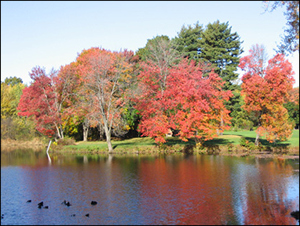 Appendix of his book Windsor Farmes, that on December 18,1669, “John Osborne sold all his timber East of the Connecticut River fitt to saw at the sawmill to John and Nathaniel Bissell” but stipulated that they must not cut any within a mile of the river. “. . . but all the oaks fit for shingles and clapboard” Osborne reserved for his own use. The payment to John Osborne for the privilege of cutting this timber was “500 feet of good boards at the saw mill and slabs enough to lay in the lower floor of my house on the East side.” Stiles states that John is listed on the 1675 tax rolls as in the class having “a family, a horse [and] four oxen.” The List of Freemen of Windsor, CT. submitted by Samuel Wolcott, on March 1, 1850 reports the name of “OSBON, John Senr” in the following list dated “Oct 7th, 1669. Acount taken of all such persons as dwell within the limets of Windsor, and have bin approved of to be freemen, and alowed to take the oath of freedom.”
Appendix of his book Windsor Farmes, that on December 18,1669, “John Osborne sold all his timber East of the Connecticut River fitt to saw at the sawmill to John and Nathaniel Bissell” but stipulated that they must not cut any within a mile of the river. “. . . but all the oaks fit for shingles and clapboard” Osborne reserved for his own use. The payment to John Osborne for the privilege of cutting this timber was “500 feet of good boards at the saw mill and slabs enough to lay in the lower floor of my house on the East side.” Stiles states that John is listed on the 1675 tax rolls as in the class having “a family, a horse [and] four oxen.” The List of Freemen of Windsor, CT. submitted by Samuel Wolcott, on March 1, 1850 reports the name of “OSBON, John Senr” in the following list dated “Oct 7th, 1669. Acount taken of all such persons as dwell within the limets of Windsor, and have bin approved of to be freemen, and alowed to take the oath of freedom.”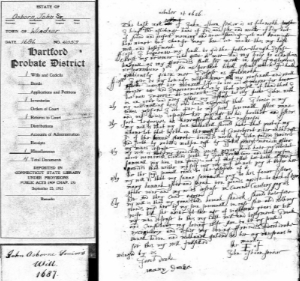

 Ann’s father purchased land in 1640 in Windsor and she lived there with him. On the day of her marriage to John Osborne, May 19, 1645, Osborne purchased the lot and house next to Ann’s father’s home. (Mouse over marriage image record left.)
Ann’s father purchased land in 1640 in Windsor and she lived there with him. On the day of her marriage to John Osborne, May 19, 1645, Osborne purchased the lot and house next to Ann’s father’s home. (Mouse over marriage image record left.)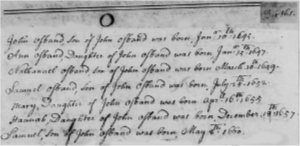
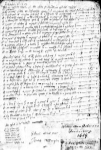
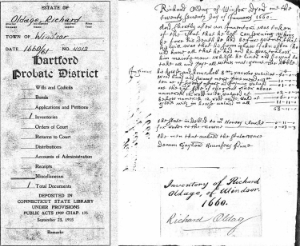
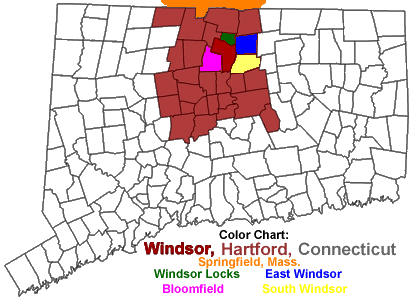 Windsor, Connecticut's was first launched in 1633 when settlers sailed from Plymouth Colony in Massachusetts to establish themselves at the confluence of the Farmington and Connecticut rivers.
Windsor, Connecticut's was first launched in 1633 when settlers sailed from Plymouth Colony in Massachusetts to establish themselves at the confluence of the Farmington and Connecticut rivers. 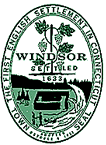 In 1635, sixty or more people, led by the Reverends Maverick and Warham arrived, having trekked overland from Dorchester, Massachusetts. According to Frank Thistlewaite, in his book Dorset Pilgrims, they arrived in the New World five years earlier on the ship Mary and John from Plymouth, England, and settled in Dorchester. Reverend Warham promptly renamed the settlement, Dorchester. During the next few years, more settlers arrived from Dorchester, outnumbering and soon displacing the original Plymouth contingent, who mostly returned to Plymouth.
In 1635, sixty or more people, led by the Reverends Maverick and Warham arrived, having trekked overland from Dorchester, Massachusetts. According to Frank Thistlewaite, in his book Dorset Pilgrims, they arrived in the New World five years earlier on the ship Mary and John from Plymouth, England, and settled in Dorchester. Reverend Warham promptly renamed the settlement, Dorchester. During the next few years, more settlers arrived from Dorchester, outnumbering and soon displacing the original Plymouth contingent, who mostly returned to Plymouth.